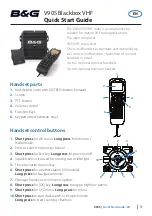
30
MDS 4710/9710 I/O Guide
MDS 05-3305A01, Rev. B
If an alarm does exist, a two-digit code (00–31) is displayed and the
alarm is identified as “Major” or “Minor.” A brief description of the
alarm code is also given.
If more than one alarm exists, the word
MORE
appears at the bottom of
the screen and additional alarms are viewed by pressing the
key. Detailed descriptions of event codes are provided in Table 9 on
page 32.
TEMP
This command displays the internal temperature of the transceiver in
degrees Celsius.
TOT [1-255, ON, OFF]
This command sets or displays the transmitter Time-out Timer value
(1–255 seconds), as well as the timer status (
ON
or
OFF
). If the timer is
on, and the radio remains keyed for a longer duration than the
TOT
value,
the transmitter is automatically unkeyed.
When this happens, the radio must be commanded back to an unkeyed
state before a new keying command is accepted. The default timer value
is 30 seconds.
TX [xxx.xxxx]
This command selects or displays the radio’s transmit frequency in
MHz. The frequency step size is 6.25 kHz.
If the customer frequency has not been programmed at the factory, a
default frequency will be programmed in the radio near the center of the
frequency band.
UNIT [10000...65000]
The unit address is factory programmed to the last five digits of the
serial number.
6.0
TROUBLESHOOTING
Successful troubleshooting of the radio system is not difficult, but it
requires a logical approach. It is best to begin troubleshooting at the
master station, as the rest of the system depends on the master for
polling commands. If the master station has problems, the operation of
the entire network can be compromised.
It is good practice to start by checking the simple things. For proper
operation, all radios in the network must meet these basic requirements:
• Adequate and stable primary power. The radio contains an inter-
nal self-resetting fuse (4A). Remove primary power to reset.
ENTER
















































